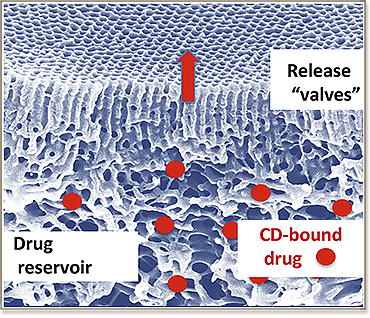

Journal of Membrane Science, Volume 584, 15 August 2019, Pages 1-8
 Asymmetric block copolymer membranes can be facilely prepared via non-solvent induced phase separation combined with self-assembly. The membrane is characterized by a thin layer of highly ordered and uniform cylindrical nano-channels on top of a non-ordered macroporous sponge-like layer. Up to date, most studies concerning block copolymer membranes are focused on separation applications. In this work, highly adsorptive and adhesive isoporous block copolymer membranes have been fabricated. Because of the functionalization with cyclodextrin, the membrane shows excellent affinity to guest molecules. Moreover, the membrane is biocompatible and is adhesive to various substrates (e.g. glass, silicon, gold and stainless steel). Triclosan as a model drug was utilized to demonstrate the applicability of the membranes as a drug reservoir. A high loading capacity (305.5 μg cm−2) was achieved. The release behavior was investigated under various pH values in vitro. A long-time extended drug release was achieved without showing an initial burst effect. Furthermore, pH-responsive release behavior was observed. The triclosan-loaded membrane exhibited a significant antibacterial effect due to the triclosan release; the diffusion out of the membrane was evaluated using a disc diffusion assay. This study provides great potential for isoporous block copolymer membranes as a delivery platform for a wide variety of biomedical applications.
Asymmetric block copolymer membranes can be facilely prepared via non-solvent induced phase separation combined with self-assembly. The membrane is characterized by a thin layer of highly ordered and uniform cylindrical nano-channels on top of a non-ordered macroporous sponge-like layer. Up to date, most studies concerning block copolymer membranes are focused on separation applications. In this work, highly adsorptive and adhesive isoporous block copolymer membranes have been fabricated. Because of the functionalization with cyclodextrin, the membrane shows excellent affinity to guest molecules. Moreover, the membrane is biocompatible and is adhesive to various substrates (e.g. glass, silicon, gold and stainless steel). Triclosan as a model drug was utilized to demonstrate the applicability of the membranes as a drug reservoir. A high loading capacity (305.5 μg cm−2) was achieved. The release behavior was investigated under various pH values in vitro. A long-time extended drug release was achieved without showing an initial burst effect. Furthermore, pH-responsive release behavior was observed. The triclosan-loaded membrane exhibited a significant antibacterial effect due to the triclosan release; the diffusion out of the membrane was evaluated using a disc diffusion assay. This study provides great potential for isoporous block copolymer membranes as a delivery platform for a wide variety of biomedical applications.